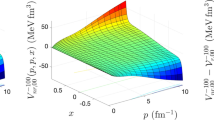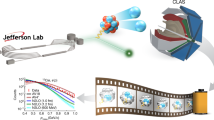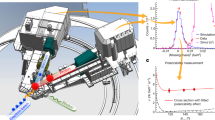Abstract
THE discovery by Rabi and his collaborators1 that the deuteron in its ground state possesses an electric quadrupole moment is of considerable theoretical importance, since it clearly shows that the forces acting between a proton and a neutron must to a quite appreciable extent depend on the spatial orientations of the spins of the heavy particles. It is well known that the vector meson theory of nuclear forces formally provides such a directional coupling, though of so strongly singular a type that it can only be given a definite meaning by taking recourse to some arbitrary cutting-off prescription. Now, Bethe2 has recently examined the question how such a cutting-off should be performed, in a theory giving rise to charge-independent nuclear forces, in order to obtain the correct positions of the ground-level and the excited 1S-level of the deuteron. He was led to the conclusion that, while the way in which the cutting-off is performed is of small influence on the results, the value to be assumed for the cutting-off radius depends critically on the combination of charged and neutral meson fields adopted: if one uses the symmetrical combination of meson fields suggested by Kemmer3, the cutting-off radius should be chosen larger than the range of the nuclear forces, and a reasonable value of this radius can only be obtained if the meson field is assumed to be purely neutral. This last assumption amounts of course to giving up the remarkable connexions suggested by the symmetrical theory between the problem of nuclear forces and those of cosmic ray phenomena, beta decay and especially the magnetic moments of proton and neutron.
This is a preview of subscription content, access via your institution
Access options
Subscribe to this journal
Receive 51 print issues and online access
$199.00 per year
only $3.90 per issue
Buy this article
- Purchase on Springer Link
- Instant access to full article PDF
Prices may be subject to local taxes which are calculated during checkout
Similar content being viewed by others
References
Kellogg, Rabl, Ramsey and Zacharias, Phys. Rev., 55, 318 (1939).
Bethe, H., Phys. Rev., 55, 1130 (1939).
Kemmer, N., Proc. Camb. Phil. Soc., 34, 351 (1938).
Moller, C., and Rosenfeld, L., NATURE, 143, 241 (1939).
Author information
Authors and Affiliations
Rights and permissions
About this article
Cite this article
MOLLER, C., ROSENFELD, L. The Electric Quadrupole Moment of the Deuteron and the Field Theory of Nuclear Forces. Nature 144, 476–477 (1939). https://doi.org/10.1038/144476a0
Issue Date:
DOI: https://doi.org/10.1038/144476a0
Comments
By submitting a comment you agree to abide by our Terms and Community Guidelines. If you find something abusive or that does not comply with our terms or guidelines please flag it as inappropriate.



